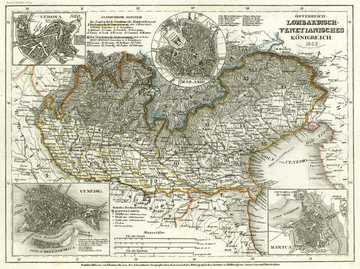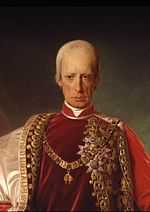Kingdom of Lombardy–Venetia
| Kingdom of Lombardy–Venetia Regno Lombardo–Veneto (it) Königreich Lombardo–Venetien (de) Österreichisches Italien ("Austrian Italy")[1] | ||||||
| ||||||
| ||||||
 Outline of the Kingdom in 1852, superimposed on modern borders. | ||||||
| Capital | Milan and Venice (1815–1859) Venice (1859–1866) | |||||
| Languages | Italian, German | |||||
| Religion | Roman Catholic | |||||
| Government | Absolute monarchy | |||||
| King | ||||||
| - | 1815–1835 | Francis I | ||||
| - | 1835–1848 | Ferdinand I | ||||
| - | 1848–1866 | Francis Joseph I | ||||
| Viceroy | ||||||
| - | 1815 | Heinrich XV | ||||
| - | 1857–1859 | Ferdinand Joseph | ||||
| History | ||||||
| - | Congress of Vienna | 9 June 1815 | ||||
| - | Five Days of Milan | 22 March 1848 | ||||
| - | Treaty of Zürich | 10 November 1859 | ||||
| - | Austro-Prussian War | 14 June 1866 | ||||
| - | Peace of Prague | 23 August 1866 | ||||
| - | Treaty of Vienna | 12 October 1866 | ||||
| Area | ||||||
| - | 1852 [2] | 46,782 km² (18,063 sq mi) | ||||
| Population | ||||||
| - | 1852 est.[2] | 4,671,000 | ||||
| Density | 99.8 /km² (258.6 /sq mi) | |||||
| Currency | Lombardy-Venetia pound, (1816–1860) Lombardy-Venetia florin (1860–1866) | |||||
| Today part of | | |||||

The Kingdom of Lombardy–Venetia (Italian: Regno Lombardo-Veneto, German: Königreich Lombardo–Venetien) was created at the Congress of Vienna in recognition of the House of Habsburg-Lorraine's rights to Lombardy and the former Republic of Venice after the Napoleonic Kingdom of Italy, proclaimed in 1805, had collapsed.[3] The kingdom was ruled day-to-day by viceroys appointed by the Imperial Court and resident in Milan and Venice.[2][4][5][6]
History
The Congress of Vienna combined the territories of Lombardy (which had been ruled by the Habsburgs since the 16th century, and by the Austrian branch of the family from 1713 to 1796) and Venetia (which had been under Austrian rule intermittently since 1797) into a single unit under the House of Habsburg-Lorraine.
Administratively the Kingdom comprised two independent governments in the two parts. Lombardy included the provinces of Milan, Como, Bergamo, Brescia, Pavia, Cremona, Mantova, Lodi-Crema, and Sondrio. Venetia included the provinces of Venice, Verona, Padova, Vicenza, Treviso, Rovigo, Belluno, and Udine.[7]
The Kingdom of Lombardy–Venetia was first ruled by Francis I from 1815 to his death in 1835. Ferdinand I ruled from 1835 to 1848. In Milan on 6 September 1838 he became the last king to be crowned with the Iron Crown of Lombardy. The crown was subsequently brought to Vienna after the loss of Lombardy in 1859, but was restored to Italy after the loss of Venetia in 1866.
After a popular revolution on 22 March 1848 (The Five Days of Milan), the Austrians fled from Milan, which became the capital city of the Governo Provvisorio della Lombardia (Lombardy Provisional Government). The next day, Venice also rose against the Austrians, forming the Governo Provvisorio di Venezia (Venice Provisional Government). The Austrians, after defeating the Sardinian troops at the Battle of Custoza (24–25 July 1848), entered Milan (6 August) and Venice (24 August 1849), and restored Austrian rule.
Francis Joseph I ruled over the Kingdom for the rest of its existence. His younger brother Maximilian (who later became Emperor of Mexico), served as his viceroy in Milan between 1857 and 1859.
Lombardy was annexed to the embryonic Italian state in 1859, by the Treaty of Zurich after the Second Italian War of Independence; Venetia was ceded to the Kingdom of Italy in 1866 in the aftermath of the Seven Weeks War, by the Peace of Prague.[7]
Rulers
Viceroys
- Heinrich XV, Prince of Reuss-Plauen 1814–1815
- Count Friedrich Heinrich von Bellegarde 1815–1816
- Archduke Anton Victor of Austria 1816–1818
- Archduke Rainer of Austria 1818–1848
- Count Joseph Radetzky von Radetz 1848–1857
- Archduke Maximilian of Austria 1857–1859
- Ferencz Gyulai 1859
Governors of Lombardy
- Heinrich Johann Bellegarde 1814–1816
- Francesco Saurau 1816–1818
- Giulio Strassoldo di Sotto 1818–1830
- Franz Hartig 1830–1840
- Robert von Salm-Reifferscheidt-Raitz 1840–1841
- Johann Baptist Spaur 1841–1848
- Maximilian Karl Lamoral O'Donnell 1848 (acting)
- Felix von Schwarzenberg 1848
- Franz Wimpffen 1848 (acting)
- Alberto Montecuccoli-Laderchi 1848–1849 (acting)
- Karl Borromäus Philipp zu Schwarzenberg 1849–1850 (acting)
- Michele Strassoldo-Grafenberg 1851–1857 (with the title of Lieutenant of Lombardy)
- Friedrich von Burger 1857–1859
Governors of Venetia
- Peter Goëss 1815–1819
- Ferdinand Ernst Maria von Bissingen-Nippenburg 1819–1820
- Carlo d'Inzaghi 1820–1826
- Johann Baptist Spaur 1826–1840
- Aloys Pállfy de Erdöd 1840–1848
- Ferdinand Zichy zu Zich von Vasonykeöy 1848 (acting)
- Laval Nugent von Westmeath 1848–1849 (military governor)
- Karl von Gorzowsky 1849
- Stanislaus Anton Puchner 1849–1850
- Georg Otto von Toggenburg-Sargans 1850–1855
- Kajetan von Bissingen-Nippenburg 1855–1860
- Georg Otto von Toggenburg-Sargans 1860–1866 (second time)
Kings
| Name |
Lifespan |
Reign start |
Reign end |
Notes |
Family |
Image |
| Francis I
|
12 February 1768 – 2 March 1835 (aged 67) | 9 June 1815 | 2 March 1835 | Habsburg-Lorraine |  |
|
Ferdinand I
|
19 April 1793 – 29 June 1875 (aged 82) | 2 March 1835 | 2 December 1848 (abdicated) |
Son of Francis I | Habsburg-Lorraine |  |
| Francis Joseph I
|
18 August 1830 – 21 November 1916 (aged 86) | 2 December 1848 | 12 October 1866 (deposed) |
Nephew of Ferdinand I | Habsburg-Lorraine |  |
Sources
- ↑ Pütz, Wilhelm (1855). Leitfaden bei dem Unterricht in der vergleichenden Erdbeschreibung. Freiburg.
- ↑ 2.0 2.1 2.2 Fisher, Richard S. (1852). The book of the world: Vol.2. New York.
- ↑ Rindler Schjerve, Rosita (2003). Diglossia and Power. Berlin.
- ↑ Francis Young & W.B.B. Stevens (1864). Garibaldi: his life and times. London.
- ↑ Pollock, Arthur William Alsager (1854). The United service magazine: Vol.75. London.
- ↑ Förster, Ernst (1866). Handbuch für Reisende in Italien: Vol.1. Munich.
- ↑ 7.0 7.1 Rosita Rindler Schjerve (2003) "Diglossia and Power: Language Policies and Practice in the 19th Century Habsburg Empire", ISBN 3-11-017653-X, pp. 199-200
External links
-
 Media related to Kingdom of Lombardy-Venetia at Wikimedia Commons
Media related to Kingdom of Lombardy-Venetia at Wikimedia Commons - Flags of Lombardy–Venetia
| |||||

